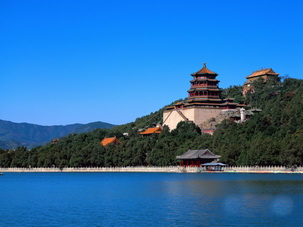 Located at the northwest suburb of Beijing, the Summer Palace was originally a royal garden and a temporary dwelling palace for emperors of Qing Dynasty, Its predecessor was the Garden of Clear Ripples (Qingyiyuan) started in 1750 and burned down by the British and French allied troops in 1860. In 1886, Empress Dowager Cixi used navy outlays and other funds in the reconstruction and renamed the park as Summer Palace in 1888.The Summer Palace in northwest suburban Beijing is the largest and most complete imperial garden existing in China.
Located at the northwest suburb of Beijing, the Summer Palace was originally a royal garden and a temporary dwelling palace for emperors of Qing Dynasty, Its predecessor was the Garden of Clear Ripples (Qingyiyuan) started in 1750 and burned down by the British and French allied troops in 1860. In 1886, Empress Dowager Cixi used navy outlays and other funds in the reconstruction and renamed the park as Summer Palace in 1888.The Summer Palace in northwest suburban Beijing is the largest and most complete imperial garden existing in China.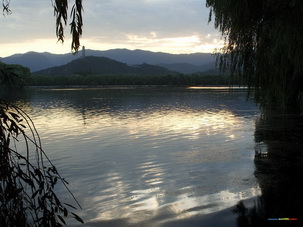
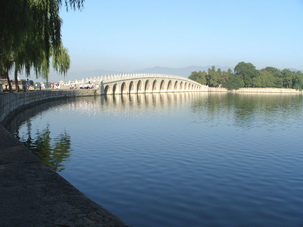
Summer Palace mainly consists of Longevity Hill (Washoushan) and Kunming Lake. Covering an area of 290.8 hectares. Of which 34 is covered by water. Hill-and water- surrounded palaces,temples and garden buildings are divided into three areas the palace area, with the Hall of Benevolence and Longevity (Renshoudian) as the center, where Cixi held court from behind a screen in most time of her late years; the residence area, with Yulan Hall, Leshou Hall and Yiyun Hall as main bodies , where the emperor and empress lived before death; the tour area integrating landscape, buildings, flower and plants, a place of tour and rest for rulers of that time. As the building center in the whole Palaces, the Tower of Buddhist Incense (Foxiangge) stands highly relying on the Hill and facing to the water.
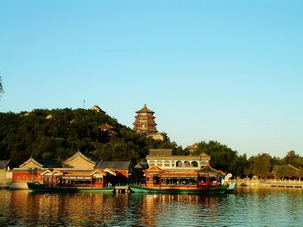
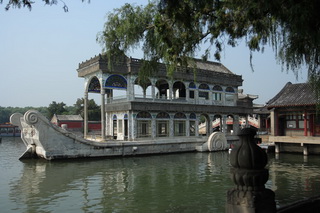
The water surface of Kunming Lake is spacious like sky, charming, gentle and appealing. In the vast mist- covered water stand the magic hills and wonder islands; the Seventeen-arch Beidge spans the green water like a rainbow. The West Dike of the lake runs from north to south. Forming a God-fiven scene together with six graceful bridges. Business on the palace market is flourishing. Towering palaces shine with the hill and water, Group peaks of West Hill (Xishan) and the Jade Spring (Yuquanshan) are even taken as the background .With masterly design and artistic architecture and integrationg the essence of Chinese garden arts, the Summer Palace has a title of Imperial Garden Museum. It is a imperial garden most completely reseved with richest landscapes and concentrated buildings. The Summer Palace was added to the world cultural heritage list in 1998.

 China Tours
China Tours Tibet Tours
Tibet Tours China Theme Tours
China Theme Tours Off The Beaten Track
Off The Beaten Track Yangtze Cruises
Yangtze Cruises China Trip Planner
China Trip Planner Travel Agents
Travel Agents China Tours
China Tours Tibet Tours
Tibet Tours China Theme Tours
China Theme Tours Off The Beaten Track
Off The Beaten Track Yangtze Cruises
Yangtze Cruises China Trip Planner
China Trip Planner Travel Agents
Travel Agents


 0086-28-85711328
0086-28-85711328 0086-28-85546015
0086-28-85546015





 Located at the northwest suburb of Beijing, the Summer Palace was originally a royal garden and a temporary dwelling palace for emperors of Qing Dynasty, Its predecessor was the Garden of Clear Ripples (Qingyiyuan) started in 1750 and burned down by the British and French allied troops in 1860. In 1886, Empress Dowager Cixi used navy outlays and other funds in the reconstruction and renamed the park as Summer Palace in 1888.The Summer Palace in northwest suburban Beijing is the largest and most complete imperial garden existing in China.
Located at the northwest suburb of Beijing, the Summer Palace was originally a royal garden and a temporary dwelling palace for emperors of Qing Dynasty, Its predecessor was the Garden of Clear Ripples (Qingyiyuan) started in 1750 and burned down by the British and French allied troops in 1860. In 1886, Empress Dowager Cixi used navy outlays and other funds in the reconstruction and renamed the park as Summer Palace in 1888.The Summer Palace in northwest suburban Beijing is the largest and most complete imperial garden existing in China.


